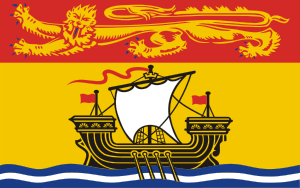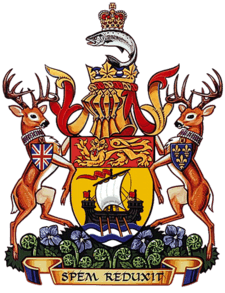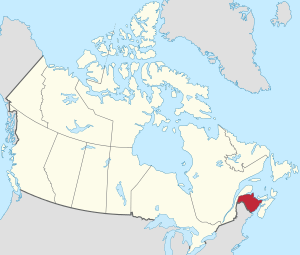New Brunswick
New Brunswick (French: Nouveau-Brunswick) is one of four Atlantic provinces on the east coast of Canada. According to the Constitution of Canada, New Brunswick is the only bilingual province. About two-thirds of the population declare themselves anglophones and one-third francophones. One-third of the population describes themselves as bilingual. Atypically for Canada, only about half of the population lives in urban areas, mostly in Greater Moncton, Greater Saint John and the capital Fredericton.
New Brunswick | |
|---|---|
| Motto(s): Latin: Spem reduxit[1] ("Hope restored") | |
| Coordinates: 46°30′00″N 66°00′00″W | |
| Country | Canada |
| Confederation | July 1, 1867 (1st, with Ontario, Quebec, Nova Scotia) |
| Capital | Fredericton |
| Largest city | Moncton |
| Largest metro | Greater Moncton |
| Government | |
| • Type | Constitutional monarchy |
| • Lieutenant Governor | Brenda Murphy |
| • Premier | Blaine Higgs (Progressive Conservatives) |
| Legislature | Legislative Assembly of New Brunswick |
| Federal representation | Parliament of Canada |
| House seats | 10 of 338 (3%) |
| Senate seats | 10 of 105 (9.5%) |
| Area | |
| • Total | 72,907 km2 (28,150 sq mi) |
| • Land | 71,450 km2 (27,590 sq mi) |
| • Water | 1,458 km2 (563 sq mi) 2% |
| Area rank | Ranked 11th |
| 0.7% of Canada | |
| Population (2016) | |
| • Total | 747,101 [2] |
| • Estimate (2020 Q2) | 780,890 [3] |
| • Rank | Ranked 8th |
| • Density | 10.46/km2 (27.1/sq mi) |
| Demonym(s) | New Brunswicker FR: Néo-Brunswickois(e) |
| Official languages | [4] |
| GDP | |
| • Rank | 9th |
| • Total (2017) | C$36.088 billion[5] |
| • Per capita | C$42,606 (11th) |
| Time zone | Atlantic: UTC−4/−3 |
| Postal abbr. | NB |
| Postal code prefix | E |
| ISO 3166 code | CA-NB |
| Flower | Purple violet |
| Tree | Balsam fir |
| Bird | Black-capped chickadee |
| Website | www |
| Rankings include all provinces and territories | |
Unlike the other Maritime provinces, New Brunswick's terrain is mostly forested uplands and much of the land is further from the coast, giving it a harsher climate. New Brunswick is 83% forested and less densely populated than the rest of the Maritimes.
Being relatively close to Europe, New Brunswick was among the first places in North America to be explored and settled by Europeans. In 1784, after an influx of refugees from the American Revolutionary War settled in the area, the province was founded on territory from the partition of Nova Scotia.[6] In 1785 Saint John became the first incorporated city in what is now Canada.[7] The province prospered in the early 1800s and the population grew rapidly, reaching about a quarter of a million by mid-century. In 1867, New Brunswick was one of four founding provinces of Canada, along with Nova Scotia and the Province of Canada (now Ontario, and Quebec).
After Confederation, wooden shipbuilding and lumbering declined, while protectionism disrupted trade ties with New England. The mid-1900s found New Brunswick to be one of the poorest regions of Canada, now mitigated by Canadian transfer payments and improved support for rural areas. As of 2002, provincial gross domestic product was derived as follows: services (about half being government services and public administration) 43%; construction, manufacturing, and utilities 24%; real estate rental 12%; wholesale and retail 11%; agriculture, forestry, fishing, hunting, mining, oil and gas extraction 5%; transportation and warehousing 5%.[8]
Tourism accounts for about 9% of the labour force directly or indirectly. Popular destinations include Fundy National Park and the Hopewell Rocks, Kouchibouguac National Park, and Roosevelt Campobello International Park. In 2013, 64 cruise ships called at Port of Saint John, carrying, on average, 2,600 passengers each.[9]
History
Early history
Indigenous peoples have been in the area since about 7000 BC. At the time of European contact, inhabitants were the Mi'kmaq, the Maliseet, and the Passamaquoddy. Although these tribes did not leave a written record, their language is present in many placenames, such as Aroostook, Bouctouche, Memramcook, Petitcodiac, Quispamsis, Richibucto and Shediac.
New Brunswick may have been part of Vinland during the Norse exploration of North America, and Basque, Breton, and Norman fishermen may have visited the Bay of Fundy in the early 1500s.[10]
European settlements
French colony
The first documented European visits were by Jacques Cartier in 1534. In 1604, a party including Samuel de Champlain visited the mouth of the Saint John River on the eponymous Saint-Jean-Baptiste Day. Now Saint John, this was later the site of the first permanent European settlement in New Brunswick.[10] French settlement eventually extended up the river to the site of present-day Fredericton. Other settlements in the southeast extended from Beaubassin, near the present-day border with Nova Scotia, to Baie Verte, and up the Petitcodiac, Memramcook, and Shepody Rivers.[11]
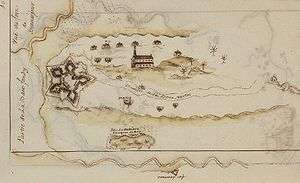
By the early 1700s the French settlements formed a part of Acadia, a colonial division of New France. Acadia covered what is now the Maritimes, as well as bits of Quebec and Maine. The British conquest of most of the Acadian peninsula occurred during the Queen Anne's War, and was formalized in the Treaty of Utrecht of 1713. After the war, French Acadia was reduced to Île Saint-Jean (Prince Edward Island) and Île-Royale (Cape Breton Island). The ownership of continental Acadia (New Brunswick) remained disputed, with an informal border on the Isthmus of Chignecto. In an effort to limit British expansion into continental Acadia, the French built Fort Beauséjour at the isthmus in 1751.
From 1749 to 1755, the British engaged in a campaign to consolidate its control over Nova Scotia. The resulting conflict led to an Acadian Exodus to French controlled territories in North America, including portions of continental Acadia. In 1755, the British captured Fort Beauséjour, severing the Acadian supply lines to Nova Scotia, and Île-Royale. Unable to make most of the Acadians sign an unconditional oath of allegiance, British authorities undertook a campaign to expel the Acadians in the initial periods of the Seven Years' War.
British colony
Continental Acadia was eventually incorporated into the British colony of Nova Scotia, with nearly all of New France being surrendered to the British with the Treaty of Paris in 1763. Acadians that returned from exile discovered several thousand immigrants, mostly from New England, on their former lands. Some settled around Memramcook and along the Saint John River.[12] In 1766, settlers from Pennsylvania founded Moncton, and English settlers from Yorkshire arrived in the Sackville area. However, settlement of the area remained slow in the mid 18th century.
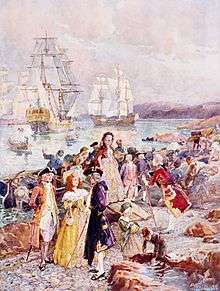
After the American Revolution, about 10,000 loyalist refugees settled along the north shore of the Bay of Fundy,[13] commemorated in the province's motto, Spem reduxit ("hope restored"). The number reached almost 14,000 by 1784, with about one in ten eventually returning to America.[14] New Brunswick was founded in 1784 upon the partition of Nova Scotia into two areas which became the Provinces of Nova Scotia and New Brunswick.[15] In the same year New Brunswick formed its first elected assembly.[16] The colony was named New Brunswick in honour of George III, King of Great Britain, King of Ireland, and Prince-elector of Brunswick-Lüneburg in what is now Germany.[17] In 1785, Saint John became Canada's first incorporated city.[18] The population of the colony reached 26,000 in 1806 and 35,000 in 1812.
The 1800s saw an age of prosperity based on wood export and shipbuilding,[18] bolstered by The Canadian–American Reciprocity Treaty of 1854 and demand from the American Civil War. St. Martins became the third most productive shipbuilding town in the Maritimes, producing over 500 vessels.[19] In 1848, responsible home government was granted[16] and the 1850s saw the emergence of political parties largely organised along religious and ethnic lines.[18] The first half of the 1800s saw large-scale immigration from Ireland and Scotland, with the population reaching 252,047 by 1861.
The notion of unifying the separate colonies of British North America was discussed increasingly in the 1860s. Many felt that the American Civil war was the result of weak central government and wished to avoid such violence and chaos.[20] The 1864 Charlottetown Conference was intended to discuss a Maritime Union, but concerns over possible conquest by the Americans, coupled with a belief that Britain was unwilling to defend its colonies against American attack, led to a request from the Province of Canada (now Ontario and Quebec) to expand the meeting's scope. In 1866 the US cancelled the Canadian–American Reciprocity Treaty, leading to loss of trade with New England and prompting a desire to build trade within British North America,[21] while Fenian raids increased support for union.[22] On 1 July 1867, New Brunswick entered the Canadian Confederation along with Nova Scotia and the Province of Canada.
Modern New Brunswick
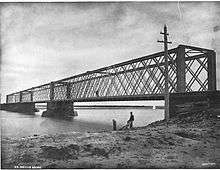
Confederation brought into existence the Intercolonial Railway in 1872, a consolidation of the existing Nova Scotia Railway, European and North American Railway, and Grand Trunk Railway. In 1879 John A. Macdonald's Conservatives enacted the National Policy which called for high tariffs and opposed free trade, disrupting the trading relationship between the Maritimes and New England. The economic situation was worsened by the decline of the wooden ship building industry. The railways and tariffs did foster the growth of new industries in the province such as textile manufacturing, iron mills, and sugar refineries,[12] many of which eventually failed to compete with better capitalized industry in central Canada.
In 1937 New Brunswick had the highest infant mortality and illiteracy rates in Canada.[23] At the end of the Great Depression the New Brunswick standard of living was much below the Canadian average. In 1940 the Rowell–Sirois Commission reported that the federal government attempts to manage the depression illustrated grave flaws in the Canadian constitution. While the federal government had most of the revenue gathering powers, the provinces had many expenditure responsibilities such as healthcare, education, and welfare, which were becoming increasingly expensive. The Commission recommended the creation of equalization payments, implemented in 1957.
After Canada joined World War II, 14 NB army units were organized, in addition to The Royal New Brunswick Regiment,[24] and first deployed in the Italian campaign in 1943. After the Normandy landings they redeployed to northwestern Europe, along with The North Shore Regiment.[24] The British Commonwealth Air Training Plan, a training program for ally pilots, established bases in Moncton, Chatham, and Pennfield Ridge, as well as a military typing school in Saint John. While relatively unindustrialized before the war, New Brunswick became home to 34 plants on military contracts from which the province received over $78 million.[24] Prime Minister William Lyon Mackenzie King, who had promised no conscription, asked the provinces if they would release the government of said promise. New Brunswick voted 69.1% yes. The policy was not implemented until 1944, too late for many of the conscripts to be deployed.[24] There were 1808 NB fatalities among the armed forces.[25]
The Acadians in northern New Brunswick had long been geographically and linguistically isolated from the more numerous English speakers to the south. The population of French origin grew dramatically after Confederation, from about 16 per cent in 1871 to 34 per cent in 1931.[26] Government services were often not available in French, and the infrastructure in Francophone areas was less developed than elsewhere. In 1960 Premier Louis Robichaud embarked on the New Brunswick Equal Opportunity program, in which education, rural road maintenance, and healthcare fell under the sole jurisdiction of a provincial government that insisted on equal coverage throughout the province, rather than the former county-based system.
The flag of New Brunswick, based on the coat of arms, was adopted in 1965. The conventional heraldic representations of a lion and a ship represent colonial ties with Europe, and the importance of shipping at the time the coat of arms was assigned.[27]
Geography
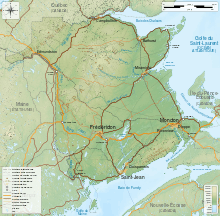
Roughly square, New Brunswick is bordered on the north by Quebec, on the east by the Atlantic Ocean, on the south by the Bay of Fundy, and on the west by the US state of Maine. The southeast corner of the province is connected to Nova Scotia at the isthmus of Chignecto.
Glaciation has left much of New Brunswick's uplands with only shallow, acidic soils which have discouraged settlement but which are home to enormous forests.[28]
Climate
New Brunswick's climate is more severe than that of the other Maritime provinces, which are lower and have more shoreline along the moderating sea. New Brunswick has a humid continental climate, with slightly milder winters on the Gulf of St. Lawrence coastline. Elevated parts of the far north of the province have a subarctic climate.
Evidence of climate change in New Brunswick can be seen in its more intense precipitation events, more frequent winter thaws, and one quarter to half the amount of snowpack.[29] Today the sea level is about 30 cm higher than it was 100 years ago, and it is expected to rise twice that much again by the year 2100.[29]
Flora and fauna
.jpg)
Most of New Brunswick[30] is forested with secondary forest or tertiary forest. At the start of European settlement, the Maritimes were covered from coast to coast by a forest of mature trees, giants by today's standards. Today less than one per cent of old-growth Acadian forest remains,[31] and the World Wide Fund for Nature lists the Acadian Forest as endangered.[32] Following the frequent large scale disturbances caused by settlement and timber harvesting, the Acadian forest is not growing back as it was, but is subject to borealization. This means that exposure-resistant species that are well adapted to the frequent large scale disturbances common in the boreal forest are increasingly abundant. These include jack pine, balsam fir, black spruce, white birch, and poplar.[32] Forest ecosystems support large carnivores such as the bobcat, Canada lynx, and black bear, and the large herbivores moose and white-tailed deer.
Fiddlehead greens are harvested from the Ostrich fern which grows on riverbanks. Furbish's lousewort, a perennial herb endemic to the shores of the upper Saint John River, is an endangered species threatened by habitat destruction, riverside development, forestry, littering and recreational use of the riverbank.[33] Many wetlands are being disrupted by the highly invasive Introduced species purple loosestrife.[34]
Geology
.jpg)
Bedrock types range from 1 billion to 200 million years old.[35] Much of the bedrock in the west and north derives from ocean deposits in the Ordovician that were subject to folding and igneous intrusion and that were eventually covered with lava during the Paleozoic, peaking during the Acadian orogeny.[12]
During the Carboniferous era, about 340 million years ago, New Brunswick was in the Maritimes Basin, a sedimentary basin near the equator. Sediments, brought by rivers from surrounding highlands, accumulated there; after being compressed, they produced the Albert oil shales of southern New Brunswick. Eventually, sea water from the Panthalassic Ocean invaded the basin, forming the Windsor Sea. Once this receded, conglomerates, sandstones, and shales accumulated. The rust colour of these was caused by the oxidation of iron in the beds between wet and dry periods.[36] Such late carboniferous rock formed the Hopewell Rocks, which have been shaped by the extreme tidal range of the Bay of Fundy.
In the early Triassic, as Pangea drifted north it was rent apart, forming the rift valley that is the Bay of Fundy. Magma pushed up through the cracks, forming basalt columns on Grand Manan.[37]
Topography
New Brunswick lies entirely within the Appalachian Mountain range. All of the rivers of New Brunswick drain into the Gulf of Saint Lawrence to the east or the Bay of Fundy to the south. These watersheds include lands in Quebec and Maine.[30]
New Brunswick and the rest of the Maritime Peninsula was covered by thick layers of ice during the last glacial period (the Wisconsinian glaciation).[38] It cut U-shaped valleys in the Saint John and Nepisiguit River valleys and pushed granite boulders from the Miramichi highlands south and east, leaving them as erratics when the ice receded at the end of the Wisconsin glaciation, along with deposits such as the eskers between Woodstock and St George, which are today sources of sand and gravel.
Demographics

The four Atlantic Provinces are Canada's least populated, with New Brunswick the third-least populous at 747,101 in 2016. The Atlantic provinces also have higher rural populations. New Brunswick was largely rural until 1951; since then, the rural-urban split has been roughly even.[39] Population density in the Maritimes is above average among Canadian provinces, which reflects their small size and the fact that they do not possess large, unpopulated hinterlands, as do the other seven provinces and three territories.
New Brunswick's 107 municipalities[40] cover 8.6% of the province's land mass but are home to 65.3% of its population. The three major urban areas are in the south of the province and are Greater Moncton, population 126,424, Greater Saint John, population 122,389, and Greater Fredericton, population 85,688.
Ethnicity and language
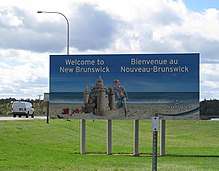
In the 2001 census, the most commonly reported ethnicities were British 40%, French Canadian and Acadian 31%, Irish 18%, other European 7%, First Nations 3%, Asian Canadian 2%. Each person could choose more than one ethnicity.[41]
According to the Canadian Constitution, both English and French are the official languages of New Brunswick,[42] making it the only officially bilingual province. Government and public services are available in both English and French.[43] For education, English-language and French-language systems serve the two linguistic communities at all levels.[43]
Anglophone New Brunswickers make up roughly two-thirds of the population, while about one-third are Francophone. Recently there has been growth in the numbers of people reporting themselves as bilingual, with 34% reporting that they speak both English and French. This reflects a trend across Canada.[44]
Religion
In the 2011 census, 84% of provincial residents reported themselves as Christian:[12] 52% were Roman Catholic, 8% Baptist, 8% United Church of Canada, 7% Anglican and 9% other Christian. Fifteen percent of residents reported no religion.
Economy
As of October 2017, seasonally-adjusted employment is 73,400 for the goods-producing sector and 280,900 for the services-producing sector.[45] Those in the goods-producing industries are mostly employed in manufacturing or construction, while those in services work in social assistance, trades, and health care. A large portion of the economy is controlled by the Irving Group of Companies, which consists of the holdings of the family of K. C. Irving. The companies have significant holdings in agriculture, forestry, food processing, freight transport (including railways and trucking), media, oil, and shipbuilding.[46]
The United States is the province's largest export market, accounting for 92% of a foreign trade valued in 2014 at almost $13 billion, with refined petroleum making up 63% of that, followed by seafood products, pulp, paper and sawmill products and non-metallic minerals (chiefly potash). The value of exports, mostly to the United States, was $1.6 billion in 2016. About half of that came from lobster. Other products include salmon, crab, and herring.[47] In 2015, spending on non-resident tourism in New Brunswick was $441 million, which provided $87 million in tax revenue.[48]
Primary sector
A large number of residents from New Brunswick are employed in the primary sector of industry. More than 13,000 New Brunswickers work in agriculture, shipping products worth over $1 billion, half of which is from crops, and half of that from potatoes, mostly in the Saint John River valley. McCain Foods is one of the world's largest manufacturers of frozen potato products. Other products include apples, cranberries, and maple syrup.[49] New Brunswick was in 2015 the biggest producer of wild blueberries in Canada.[50] The value of the livestock sector is about a quarter of a billion dollars, nearly half of which is dairy. Other sectors include poultry, fur, and goats, sheep, and pigs.
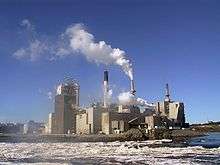
About 83% of New Brunswick is forested. Historically important, it accounted for more than 80% of exports in the mid-1800s. By the end of the 1800s the industry, and shipbuilding, were declining due to external economic factors. The 1920s saw the development of a pulp and paper industry. In the mid-1960s, forestry practices changed from the controlled harvests of a commodity to the cultivation of the forests.[26] The industry employs nearly 12,000, generating revenues around $437 million.[12]
Mining was historically unimportant in the province, but has grown since the 1950s.[51] The province's GDP from the Mining and Quarrying industry in 2015 was $299.5 million.[52] Mines in New Brunswick produce lead, zinc, copper, and potash.
Education
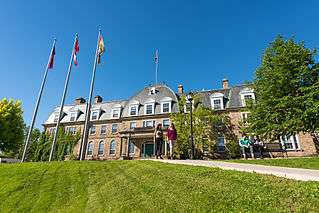
Public education elementary and secondary education in the province is administered by the provincial Department of Education and Early Childhood Development. New Brunswick has a parallel system of Anglophone and Francophone public schools.
The province also operates five public post-secondary institutions, including a college and four universities. Four public universities operate campuses in New Brunswick, including the oldest English-language university in the country, the University of New Brunswick. The other universities in the province include Mount Allison University, St. Thomas University, and the Université de Moncton. All four universities offer undergraduate, and postgraduate education. Additionally, the Université de Moncton, and the University of New Brunswick also offer professional education. Medical education programs have also been established at both the Université de Moncton and at UNBSJ in Saint John (affiliated with Université de Sherbrooke and Dalhousie University respectively).
Public colleges in the province are managed as a part of the New Brunswick Community College (NBCC) system. In addition to public institutions, the province is also home to several private vocational schools, such as the Moncton Flight College; and universities, the largest being Crandall University.
Government
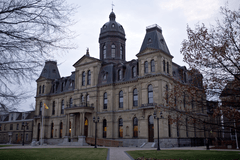
Under Canadian federalism, power is divided between federal and provincial governments. Among areas under federal jurisdiction are citizenship, foreign affairs, national defence, fisheries, criminal law, indigenous policies, and many others. Provincial jurisdiction covers public lands, health, education, and local government, among other things. Jurisdiction is shared for immigration, pensions, agriculture, and welfare.[53]
The parliamentary system of government is modelled on the British Westminster system. Forty-nine representatives, nearly always members of political parties, are elected to the Legislative Assembly of New Brunswick. The head of government is the Premier of New Brunswick, normally the leader of the party or coalition with the most seats in the legislative assembly. Governance is handled by the executive council (cabinet), with about 32 ministries.[54] Ceremonial duties of the Monarchy in New Brunswick are mostly carried out by the Lieutenant Governor of New Brunswick.
Under amendments to the province's Legislative Assembly Act in 2007, a provincial election is held every four years. The two largest political parties are the New Brunswick Liberal Association and the Progressive Conservative Party of New Brunswick. Since the 2018 election, minor parties are the Green Party of New Brunswick and the People's Alliance of New Brunswick.
Judiciary
The Court of Appeal of New Brunswick is the highest provincial court. It hears appeals from:
- The Court of Queen's Bench of New Brunswick: has jurisdiction over family law and major criminal and civil cases and is divided accordingly into two divisions: Family and Trial. It also hears administrative tribunals.[55]
- The Probate Court of New Brunswick: has jurisdiction over estates of deceased persons.
- The Provincial Court of New Brunswick: nearly all cases involving the criminal code start here.
The system consists of eight Judicial Districts, loosely based on the counties.[56] The Chief Justice of New Brunswick serves at the apex of this court structure.
Administrative divisions
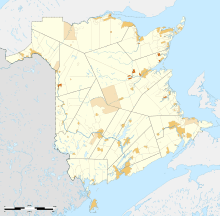
Ninety-two per cent of the land in the province, inhabited by about 35% of the population, is under provincial administration and has no local, elected representation. The 51% of the province that is Crown land is administered by the Department of Natural Resources and Energy Development.
Most of the province is administrated as a local service district (LSD), an unincorporated unit of local governance. As of 2017, there are 237 LSDs. Services, paid for by property taxes, include a variety of services such as fire protection, solid waste management, street lighting, and dog regulation. LSDs may elect advisory committees[57] and work with the Department of Local Government to recommend how to spend locally collected taxes.
In 2006 there were three rural communities. This is a relatively new entity; to be created, it requires a population of 3,000 and a tax base of $200 million.[58] In 2006 there were 101 municipalities.
Regional Service Commissions, which number 12, were introduced in 2013 to regulate regional planning and solid waste disposal, and provide a forum for discussion on a regional level of police and emergency services, climate change adaptation planning, and regional sport, recreational and cultural facilities. The commissions' administrative councils are populated by the mayors of each municipality or rural community within a region.[59]
Historically the province was divided into counties with elected governance, but this was abolished in 1966. These were further subdivided into 152 parishes, which also lost their political significance in 1966 but are still used as census subdivisions by Statistics Canada.
Provincial finances
New Brunswick has the most poorly-performing economy of any Canadian province, with a per capita income of $28,000.[60] The government has historically run at a large deficit. With about half of the population being rural, it is expensive for the government to provide education and health services, which account for 60 per cent of government expenditure. Thirty-six per cent of the provincial budget is covered by federal cash transfers.[61]
The government has frequently attempted to create employment through subsidies, which has often failed to generate long-term economic prosperity and has resulted in bad debt,[61] examples of which include Bricklin, Atcon,[62] and the Marriott call centre in Fredericton.[63]
According to a 2014 study by the Atlantic Institute for Market Studies, the large public debt is a very serious problem. Government revenues are shrinking because of a decline in federal transfer payments. Though expenditures are down (through government pension reform and a reduction in the number of public employees), they have increased relative to GDP,[64] necessitating further measures to reduce debt in the future.
In the 2014–15 fiscal year, provincial debt reached $12.2 billion or 37.7 per cent of nominal GDP, an increase over the $10.1 billion recorded in 2011–12.[64] The debt-to-GDP ratio is projected to fall to 36.7% in 2019–20.[65]
Infrastructure
Energy
Energy capacity by source in NB:
Publicly owned NB Power operates 13 of New Brunswick's generating stations, deriving power from fuel oil and diesel (1497 MW), hydro (889 MW), nuclear (660 MW), and coal (467 MW). There were 30 active natural gas production sites in 2012.[12]
Transportation
The Department of Transportation and Infrastructure maintains government facilities and the province's highway network and ferries. The Trans-Canada Highway is not under federal jurisdiction, and traverses the province from Edmundston following the Saint John River Valley, through Fredericton, Moncton, and on to Nova Scotia and Prince Edward Island.
Rail
Via Rail's Ocean service, which connects Montreal to Halifax, is currently the oldest continuously operated passenger route in North America, with stops from west to east at Campbellton, Charlo, Jacquet River, Petit Rocher, Bathurst, Miramichi, Rogersville, Moncton, and Sackville.
Canadian National Railway operates freight services along the same route, as well as a subdivision from Moncton to Saint John. The New Brunswick Southern Railway, a division of J. D. Irving Limited, together with its sister company Eastern Maine Railway form a continuous 305 km (190 mi) main line connecting Saint John and Brownville Junction, Maine.
Culture
There are about 61 historic places in New Brunswick, including Fort Beauséjour, Kings Landing Historical Settlement and the Village Historique Acadien. Established in 1842, the New Brunswick Museum in Saint John was designated as the provincial museum of New Brunswick. The province is also home to a number of other museums in addition to the provincial museum.
Arts

New Brunswick is home to a number of individuals that worked as musicians, in the performing arts, and/or the visual arts. Music of New Brunswick includes artists such as Henry Burr, Roch Voisine, Lenny Breau, and Édith Butler. Symphony New Brunswick, based in Saint John, tours extensively in the province. Symphony New Brunswick based in Saint John and the Atlantic Ballet Theatre of Canada (based in Moncton), tours nationally and internationally.
Theatre New Brunswick (based in Fredericton), tours plays around the province. Canadian playwright Norm Foster saw his early works premiere with Theatre New Brunswick. Other live theatre troops include the Théatre populaire d'Acadie in Caraquet, and Live Bait Theatre in Sackville. The refurbished Imperial and Capitol Theatres are found in Saint John and Moncton, respectively; the more modern Playhouse is in Fredericton.
Visual arts

Mount Allison University in Sackville began offering classes in 1854. The program came into its own under John A. Hammond, from 1893 to 1916. Alex Colville and Lawren Harris later studied and taught art there, and both Christopher Pratt and Mary Pratt were trained at Mount Allison. The university also opened an art gallery in 1895 and is named for its patron, John Owens of Saint John. The art gallery at Mount Allison University is presently the oldest university-operated art gallery in Canada. Modern New Brunswick artists include landscape painter Jack Humphrey, sculptor Claude Roussel, and Miller Brittain. The province is also home to the Beaverbrook Art Gallery, which was designated as the provincial art gallery in 1994.
Literature
Julia Catherine Beckwith, born in Fredericton, was Canada's first published novelist. Poet Bliss Carman and his cousin Charles G. D. Roberts were some of the first Canadians to achieve international fame for letters. Antonine Maillet was the first non-European winner of France's Prix Goncourt. Other modern writers include Alfred Bailey, Alden Nowlan, John Thompson, Douglas Lochhead, K. V. Johansen, David Adams Richards, and France Daigle. A recent New Brunswick Lieutenant-Governor, Herménégilde Chiasson, is a poet and playwright. The Fiddlehead, established in 1945 at University of New Brunswick, is Canada's oldest literary magazine.
Media
New Brunswick has four daily newspapers: the Times & Transcript, serving eastern New Brunswick; the Telegraph-Journal, based in Saint John and distributed province-wide; The Daily Gleaner, based in Fredericton; and L'Acadie Nouvelle, based in Caraquet. The three English-language dailies and the majority of the weeklies are owned and operated by Brunswick News—which is privately owned by James K. Irving. Due to its dominant position, critics have accused Brunswick News of being biased towards the Irving Group of Companies, including its reluctance to publish stories that are critical of the group.[66][67][68][69]
The Canadian Broadcasting Corporation has anglophone television and radio operations in Fredericton. Télévision de Radio-Canada is based in Moncton. CTV and Global also operate stations in New Brunswick, which operate largely as sub-feeds of their stations in Halifax as part of regional networks.
References
- Ann Gorman Condon. "Winslow Papers >> Ann Gorman Condon >> The New Province: Spem Reduxit". University of New Brunswick. Archived from the original on March 3, 2016. Retrieved June 8, 2016.
- "Population and dwelling counts, for Canada, provinces and territories, 2011 and 2006 censuses". Statcan.gc.ca. February 8, 2012. Archived from the original on March 7, 2014. Retrieved February 8, 2012.
- "Population by year of Canada of Canada and territories". Statistics Canada. September 26, 2014. Archived from the original on June 19, 2016. Retrieved September 29, 2018.
- "My Linguistic Rights". Office of the Commissioner of Official Languages for New Brunswick. Retrieved 7 March 2019.
- Statistics Canada (11 September 2019). "Table: 36-10-0222-01 Gross domestic product, expenditure-based, provincial and territorial, annual (x 1,000,000)". Retrieved 11 September 2019.
- "TERRITORIAL DEVELOPMENT: Founding of the Province of New Brunswick". Provincial Archives of New Brunswick. Government of New Brunswick. Retrieved 5 May 2020.
- "Saint John, NB". Canadian Encyclopedia. Retrieved 12 June 2017.
- "Provincial Gross Domestic Product by Industry" (PDF). Statistics Canada. Archived (PDF) from the original on December 5, 2014. Retrieved November 19, 2017.
- "New Brunswick Tourism Indicators Summary Report" (PDF). Government of New Brunswick. September 2014. Archived (PDF) from the original on March 29, 2017. Retrieved November 19, 2017.
- "Local history". Archived from the original on June 18, 2017. Retrieved November 12, 2017.
- Arsenault, Bona; Alain, Pascal (January 1, 2004). Histoire des Acadiens (in French). Les Editions Fides. ISBN 9782762126136. Archived from the original on March 28, 2018.
- "New Brunswick". Historica Canada. Archived from the original on December 13, 2017. Retrieved November 13, 2017.
- Bell, David (2015). American Loyalists to New Brunswick: The ship passenger lists. Formac Publishing Company. p. 7. ISBN 9781459503991. Archived from the original on December 31, 2016.
- Christopher Moore, The Loyalists, Revolution, Exile, Settlement, 1984, pp. 244-252 ISBN 0-7710--6093-9
- Slumkoski, Corey (2005). "The Partition of Nova Scotia". The Winslow Papers. Electronic text centre (UNB Libraries). Retrieved 5 May 2020.
On 18 June 1784 ... the province of New Brunswick formally came into existence.
- "Responsible Government". Historica Canada. Archived from the original on December 12, 2017. Retrieved November 13, 2017.
- "New Brunswick's provincial symbols". Government of Canada. August 15, 2017. Archived from the original on November 18, 2017. Retrieved November 12, 2017.
- "New Brunswick". Encyclopedia Britannica. Archived from the original on November 14, 2017. Retrieved November 13, 2017.
- "Living History". Archived from the original on August 4, 2017. Retrieved September 14, 2017.
- "Confederation". Historica Canada. Archived from the original on November 26, 2017. Retrieved November 13, 2017.
- "Reciprocity". Historica Canada. Archived from the original on December 14, 2017. Retrieved November 13, 2017.
- "New Brunswick and Confederation". Historica Canada. Archived from the original on December 14, 2017. Retrieved November 13, 2017.
- "New Brunswick". Archived from the original on June 2, 2016. Retrieved June 29, 2016.
- New Brunswick at War. Provincial Archives of New Brunswick. 1995. pp. 1–13.
- Bercuson, David J.; Granatstein, J.L. (1993). Dictionary Of Canadian Military History. Oxford University Press. ISBN 978-0195408478.
- Forbes, Ernest R. "New Brunswick". Archived from the original on June 22, 2016. Retrieved June 29, 2016.
- "Symbols". Service New Brunswick. Archived from the original on April 11, 2017. Retrieved November 15, 2017.
- "Landforms and Climate". Ecological Framework of Canada. Archived from the original on August 3, 2017. Retrieved November 26, 2017.
- "How is Climate Change Affecting New Brunswick?". Government of New Brunswick. December 14, 2010. Archived from the original on December 1, 2017. Retrieved November 25, 2017.
- Burrel, Brian C; Anderson, James E (1991). "Regional Hydrology of New Brunswick". Adian Water Resources Journal /. 16 (4): 317–330. doi:10.4296/cwrj1604317.
- Noseworthy, Josh. "A WALK IN THE WOODS: ACADIAN OLD-GROWTH FOREST". Nature Conservancy Canada. Retrieved 27 July 2018.
- Simpson, Jamie. "Restoring the Acadian Forest" (PDF). Retrieved 27 July 2018.
- "Furbish's Lousewort". Species at Risk Public Registry. Government of Canada. Archived from the original on October 13, 2017. Retrieved November 25, 2017.
- "Purple loosestrife". New Brunswick Alliance of Lake Associations. Archived from the original on November 30, 2017. Retrieved November 26, 2017.
- "Bedrock Mapping". Government of New Brunswick. January 29, 2013. Archived from the original on November 14, 2017. Retrieved November 14, 2017.
- Atlantic Geoscience Society (2001). Williams, Graham; Fensome, Robert (eds.). The last billion years : a geological history of the Maritime Provinces of Canada. Halifax, NS: Nimbus Publishing. ISBN 1-55109-351-0.
- "Geology". Archived from the original on November 16, 2017. Retrieved November 15, 2017.
- Sanger, David (2005). "Pre-European Dawnland: Archaeology of the Maritime Peninsula". In Hornsby, S.J.; Reid, J.G. (eds.). New England and the Maritime Provinces: Connections and Comparisons. McGill-Queen's University Press. p. 15. ISBN 0-77-352865-2.
- "Population, urban and rural, by province and territory (New Brunswick)". Statistics Canada. January 15, 2001. Archived from the original on October 10, 2017. Retrieved November 18, 2017.
- "Welcome to the Association of Municipal Administrators of New Brunswick". The Association of Municipal Administrators of New Brunswick. 2015. Archived from the original on August 1, 2015. Retrieved August 16, 2015.
- "Ethnic Origin (232), Sex (3) and Single and Multiple Responses (3) (2001 Census)". 2.statcan.ca. Archived from the original on January 1, 2017. Retrieved September 23, 2013.
- "Official Languages Act". Government of New Brunswick. Archived from the original on December 1, 2017. Retrieved November 17, 2017.
- "FACTSHEET 1 - Government and public services" (PDF). Your language rights in New Brunswick. Office of the Commissioner of Official Languages for New Brunswick. March 2017. Retrieved 25 April 2020.
- "New Brunswick bilingualism rate rises to 34%". CBC. Archived from the original on November 6, 2017. Retrieved November 17, 2017.
- "Employment by major industry group, seasonally adjusted, by province (monthly) (New Brunswick)". Statistics Canada. Archived from the original on November 16, 2017. Retrieved November 16, 2017.
- Livesey, Bruce (6 June 2016). "What have the Irvings done to New Brunswick?". National Observer. Retrieved 30 June 2019.(subscription required)
- "New Brunswick agrifood and seafood export highlights 2016" (PDF). Government of New Brunswick. Archived (PDF) from the original on August 8, 2017. Retrieved November 17, 2017.
- "Tourism contributes to economy". Government of New Brunswick. August 26, 2016. Archived from the original on November 16, 2017. Retrieved November 16, 2017.
- "Crops". Government of New Brunswick. Archived from the original on November 17, 2017. Retrieved November 17, 2017.
- acadienouvelle.com: "La production de bleuets sauvages prend de l’expansion au Nouveau Brunswick" Archived December 21, 2016, at the Wayback Machine, 21 Apr 2016
- Cranstone, D. A., & Canada. (2002). A history of mining and mineral exploration in Canada and outlook for the future. https://www.mineralsed.ca/site/assets/files/3452/ahistoryofmining_mineralexplorationincanada-nrcan.pdf
- Statistics Canada (11 September 2019). "Table: 36-10-0402-01 Gross domestic product (GDP) at basic prices, by industry, provinces and territories (x 1,000,000)". Retrieved 11 September 2019.
- "Canada's Legal System – Sharing of Legislative Powers in Canada". University of Ottawa. Archived from the original on August 22, 2017. Retrieved November 17, 2017.
- "Members of the Executive Council". Government of New Brunswick. Archived from the original on October 5, 2017. Retrieved November 17, 2017.
- "New Brunswick Courts". Archived from the original on August 5, 2016. Retrieved June 29, 2016.
- "COURT OF QUEEN'S BENCH OF NEW BRUNSWICK". Archived from the original on July 13, 2016. Retrieved June 29, 2016.
- "Local Service Districts (LSDs)". Government of New Brunswick. Archived from the original on December 1, 2017. Retrieved November 17, 2017.
- Beckley, Thomas M. "New Brunswick". State of Rural Canada. Archived from the original on December 1, 2017. Retrieved November 17, 2017.
- Canada, Government of New Brunswick. "Structure of the new Regional Service Commissions". www2.gnb.ca. Archived from the original on October 10, 2017.
- "New Brunswick's 'struggling' economy ranks near bottom of report". CBC. Archived from the original on October 16, 2015. Retrieved November 16, 2017.
- Patriquin, Martin. "Can anything save New Brunswick?". Maclean's. Archived from the original on November 16, 2017. Retrieved November 16, 2017.
- "Atcon was so badly managed, taxpayers' $63M was never going to save it, AG finds". CBC. Archived from the original on October 8, 2017. Retrieved November 16, 2017.
- "Fredericton call centre closure will cost 265 jobs". CBC. Archived from the original on March 28, 2018. Retrieved November 16, 2017.
- Murrell, David; Fantauzzo, Shawn (2014). "New Brunswick's Debt and Deficit" (PDF). Atlantic Institute for Market Studies. Archived (PDF) from the original on October 10, 2017. Retrieved November 17, 2017.
- "Canadian Federal and Provincial Fiscal Tables" (PDF). Economic Reports. Royal Bank of Canada. 14 January 2020. Retrieved 18 January 2020.
- "Hot scoop burns reporter at Irving paper". Toronto Star. Retrieved 30 June 2019.
- "Newspaper ownership in Canada: an overview of the Davey Committee and Kent Commission studies (PRB 99-35E)". Government of Canada. Retrieved 30 June 2019.
- Livesey, Bruce (6 July 2016). "The Irvings' media monopoly and its consequences". National Observer. Retrieved 30 June 2019.
- "Media convergence, acquisitions and sales in Canada". CBC News. Retrieved 3 April 2012.
External links
| Wikimedia Commons has media related to New Brunswick. |
| Wikivoyage has a travel guide for New Brunswick. |
| Look up New Brunswick in Wiktionary, the free dictionary. |
